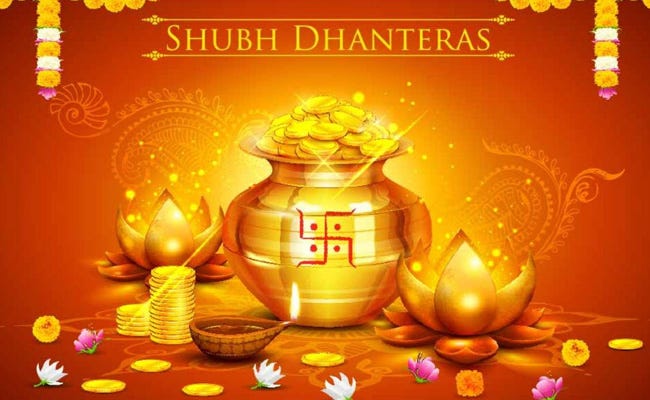Dhan Teras: Make Each Moment of Your Life a "Golden" One
Dhan Teras: Tradition, Significance, and Contemporary Trends.
Dhan Teras: A Prelude to Diwali's Luminescence
Dhan Teras, or Dhantrayodashi, observed on the 13th day of Krishna Paksha in the month of Kartik and falling this year on 18 October, marks the ceremonial beginning of the Diwali festivities. On this auspicious day, we extend our warmest felicitations to all. More than just a prelude to Diwali, Dhan Teras ushers in an atmosphere of light, prosperity, and spiritual reflection. Rooted in ancient cultural and religious traditions, this revered occasion embodies the rich tapestry of Indian heritage. It holds a distinguished place in the Hindu calendar, blending historical significance, ritual practices, and evolving contemporary relevance in a manner that continues to inspire and unite communities across the nation.
As twilight descends on Dhan Teras, the Puja Muhurat for most of India—7:15 PM to 8:20 PM IST (with minor variations across cities)—heralds a symphony of lamps, rituals, and renewal that sets the stage for Diwali’s grandeur. This festival is a confluence of mythology, economic activity, and familial bonds, offering a vivid microcosm of India’s diverse yet harmonious cultural landscape. Beyond the traditional purchase of precious metals, the essence of Dhan Teras lies in its affirmation of health, wealth, and well-being—values that render it an indispensable prologue to the Festival of Lights.
Historical Origin and Mythological Significance
The origins of Dhan Teras are deeply rooted in Hindu mythology and ancient scriptures. One popular legend recounts the story of the god Dhanvantari, an avatar of Lord Vishnu, who emerged during the Samudra Manthan, the churning of the cosmic ocean. He appeared with a jar of Amrita, the elixir of life, symbolizing the birth of Ayurveda and wellness.
Another legend involves King Hima’s son, who was destined to die by a snake bite on the fourth day of his marriage. On that day, his wife piled up gold and silver coins at the entrance of the sleeping chamber and lit lamps all around. She kept her husband awake by narrating stories and singing songs. When Yama, the god of death, arrived in the guise of a serpent, he was blinded by the dazzle of the coins and lamps and left peacefully, sparing the Prince’s life.
Traditional Practices
Traditionally, Dhan Teras is considered an auspicious day for buying gold, silver, and other metals, especially utensils and ornaments. This practice is believed to bring good luck, prosperity, and wealth to the family. It’s also a day when many perform Lakshmi Puja, worshiping the goddess of wealth and prosperity.
In addition to purchasing metals, many people renovate and decorate their homes, light diyas (lamps), and prepare special dishes. The day is marked by a festive spirit, with people donning new clothes and exchanging gifts.
The Goddess Lakshmi Connection
Dhanteras is intrinsically connected to the worship of Goddess Lakshmi, the deity of wealth, prosperity, and fortune. On this auspicious day, people perform Lakshmi Puja, seeking her divine blessings for financial well-being and success in the year ahead. For business communities and traders, Dhanteras also holds particular significance as it often marks the end of the financial year. They traditionally inaugurate new account books, known as bahi-khata, on this day, accompanied by prayers to both Lord Ganesha and Goddess Lakshmi. This symbolic ritual represents a fresh financial start, embodying the hopes for prosperity and good fortune in the business year to come.
Geographical Spread and Cultural Variations
While Dhan Teras is predominantly celebrated in India, it has also gained popularity among Hindu communities worldwide. Regions across India observe the festival with slight variations in rituals and customs, reflecting the diverse cultural fabric of the country. In western India, particularly in Gujarat and Maharashtra, the festival is celebrated with great fervour. In southern states, the focus might be more on buying new utensils than gold.
Contemporary Trends and Commercialization
In recent years, Dhan Teras has seen a significant transformation, particularly in its commercial aspect. The festival has become synonymous with major shopping sprees, with retailers and businesses offering substantial discounts and special deals, especially on gold and electronic items. This commercialization has led to debates about the dilution of the festival's traditional essence.
The trend of buying gold on Dhan Teras is not just a religious or cultural practice but also reflects the Indian affinity for gold as a valuable asset. India has one of the largest private gold reserves globally, and this festival amplifies the demand for gold, significantly impacting the economy.
Summing Up: Tradition vs. Modern Interpretation
This year’s Dhanteras has felt noticeably subdued. Gold has shattered the psychological barrier of US $4,000 per ounce, even touching US $4,380 per ounce in mid-October, with domestic prices soaring to approximately ₹1,28,395 per 10 grams (around ₹12,840 per gram) for 24-carat gold. At such unprecedented levels, many middle-class families have been compelled to limit themselves to symbolic or token purchases. Silver prices, too, are elevated at roughly ₹1.84 lakh per kilogram (about ₹184 per gram) for 99.9% purity, further discouraging substantial buying.
The anticipated relief from reduced GST—scheduled to take effect from the first Navratra on 22 September—has not fully reached consumers due to issues such as relabelling, handling of old stock, and other technical delays, diluting the intended benefit. As a result, this year’s Dhanteras feels more restrained compared to previous years. Yet, the essence of the festival endures, reminding us that its true spirit lies not only in material acquisition but in health, prosperity, and spiritual renewal. With hope in our hearts, we look forward to more equitable economic growth in the coming year, so that future celebrations may once again reflect both abundance and tradition.









Dhanteras is now more symbolic if at all and has lost its shine and glitter. The advertisements show how this occasion has converted into marketing tsunami of everything possible under the earth.
At 1.28 lakh gold can now be bought only by the Treasury.
आप सब जी नू धन तेरस दियाँ हार्दिक शुभकामनवा 🙏🙏